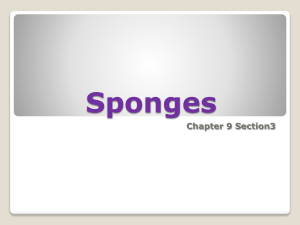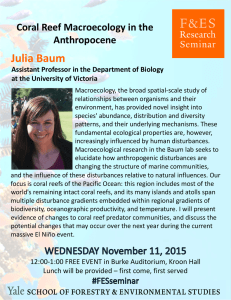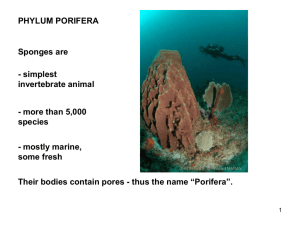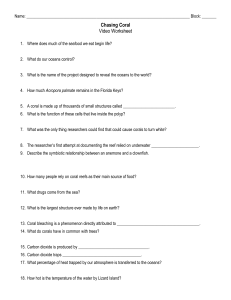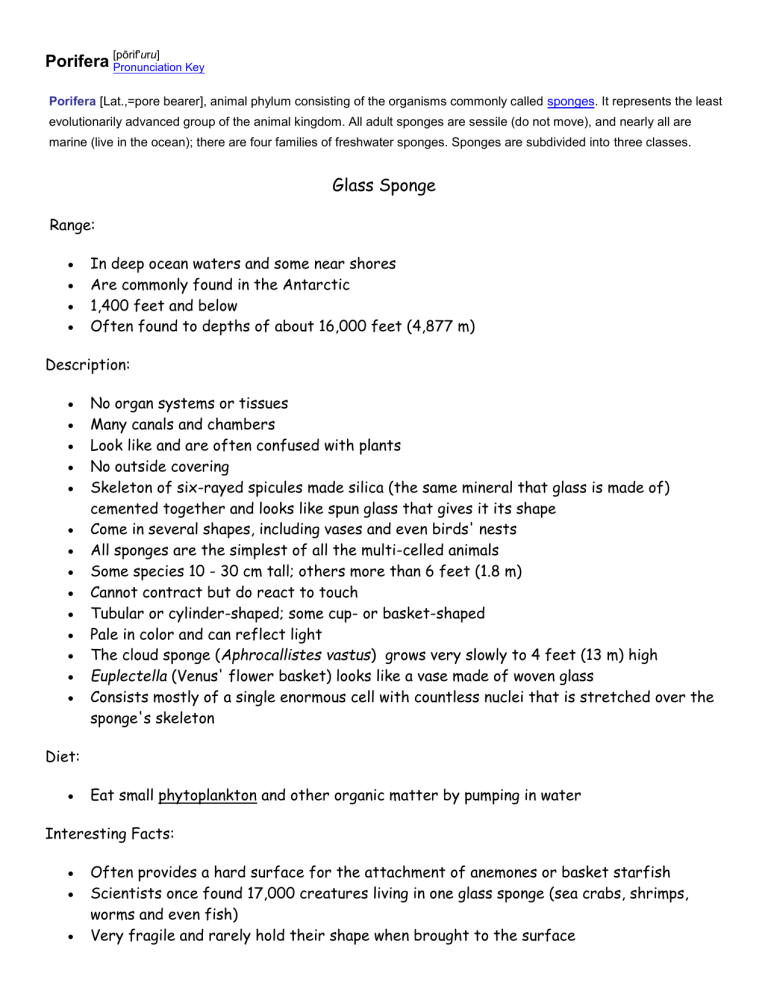
Porifera [pōrif'uru] Pronunciation Key Porifera [Lat.,=pore bearer], animal phylum consisting of the organisms commonly called sponges. It represents the least evolutionarily advanced group of the animal kingdom. All adult sponges are sessile (do not move), and nearly all are marine (live in the ocean); there are four families of freshwater sponges. Sponges are subdivided into three classes. Glass Sponge Range: In deep ocean waters and some near shores Are commonly found in the Antarctic 1,400 feet and below Often found to depths of about 16,000 feet (4,877 m) Description: No organ systems or tissues Many canals and chambers Look like and are often confused with plants No outside covering Skeleton of six-rayed spicules made silica (the same mineral that glass is made of) cemented together and looks like spun glass that gives it its shape Come in several shapes, including vases and even birds' nests All sponges are the simplest of all the multi-celled animals Some species 10 - 30 cm tall; others more than 6 feet (1.8 m) Cannot contract but do react to touch Tubular or cylinder-shaped; some cup- or basket-shaped Pale in color and can reflect light The cloud sponge (Aphrocallistes vastus) grows very slowly to 4 feet (13 m) high Euplectella (Venus' flower basket) looks like a vase made of woven glass Consists mostly of a single enormous cell with countless nuclei that is stretched over the sponge's skeleton Diet: Eat small phytoplankton and other organic matter by pumping in water Interesting Facts: Often provides a hard surface for the attachment of anemones or basket starfish Scientists once found 17,000 creatures living in one glass sponge (sea crabs, shrimps, worms and even fish) Very fragile and rarely hold their shape when brought to the surface Venus's-flower-basket (Euplectella) supplies a home for certain shrimps that become trapped in the spicules. Crabs most often live in this species but as they grow, they are too big to get back out. They have to live the rest of their lives inside the sponge. Japanese like to use them in their wedding ceremonies as symbols of two people joining together happily, just like the sea creatures living inside the glass sponges In 1870 during the Challenger mission, a branching glass sponge fossil believed to be 375 million years old was found. When it dies, their tissue falls apart but the skeleton remains to rise to the surface. Class Calcarea (Calcareous Sponges) Sponges in this class are typified by skeletal spicules composed of calcium carbonate. Calcareous sponges are small, usually only a few inches high, and are generally dull in appearance, although several species are brightly colored. Members of this class are among the simplest sponges, There are approximately 150 known species, exclusively marine and shallow-water dwellers. any of a class (Calcispongiae, or Calcarea) of sponges characterized by skeletons composed of calcium carbonate spicules (needlelike structures). Calcareous sponges occur mainly on the rocky bottoms of the continental shelves in temperate, shallow waters. Most are small, seldom exceeding 15 cm (6 inches). Class Demospongiae (Demosponges) Most sponges belong in this class. It includes sponges with a skeleton made up of silicon-containing spicules or spongin fibers or both. The Demospongiae vary in size from small to very large in size. Many are brightly colored. The freshwater sponges belong to this class; they are frequently green because of symbiotic algae that live in the amoebocytes. The fibrous sponges also belong to this class; they include the common bath sponges, and most of the other sponges used commercially. The boring sponges (family Clionidae) are extremely interesting because of their ability to bore into calcareous rocks and mollusk shells. They begin their boring as larvae and spend their lives in the tunnels they form. Sulfur sponges (Cliona species) are bright yellow boring forms inhabiting shallow waters on the east and west coasts of the United States. Stinging-Celled Animals: Cnidarians are incredibly diverse in form, as evidenced by colonial siphonophores, massive medusae and corals, feathery hydroids, and box jellies with complex eyes. Yet, these diverse animals are all armed with stinging cells called nematocysts. The name Cnidaria comes from the Greek word "cnidos", which means stinging nettle. Casually touching many cnidarians will make it clear how they got their name when their nematocysts eject barbed threads tipped with poison. Many thousands of cnidarian species live in the world's oceans, from the tropics to the poles, from the surface to the bottom. Some even burrow. A smaller number of species are found in rivers and fresh water lakes. Cnidaria is a phylum within Kingdom Animalia which consists of hydras, jellies (or jellyfish), sea anemones, and corals. All cnidarians are radially symmetrical, and there are two main radially symmetrical body types. The first of these types is known as a polyp. A polyp consists of a cylindrical body with tentacles projecting from one end, while the other end is anchored to something. The second type is known as a medusa, which consists of an umbrella- shaped body fringed by tentacles at the edge. Unlike the polyp form, the medusa floats freely in the water. Any given cnidarian species can exist in either the polyp form, or the medusa form, and some life cycles include both polyp and medusa forms. In all cnidarians, the mouth leads directly into the gastrovascular cavity, a digestive cavity. Because there is no anus, excess food and waste products must exit through the mouth, so the digestive system is considered incomplete. This cavity is filled with fluid which services internal cells, provides body support, and help maintain structure. A third distinguishing aspect of cnidarians is the fact that they are all carnivores which use tentacles to capture their prey, and then pull the prey into the mouth, but it the specialized cells on these tentacles which make them especially unique. These cells, called cnidocytes, are on the surface of the tentacles, and function both in the capture of prey and for defense. On the tip of each cnidocyte there is a section known as the "trigger". When this area of the cell is touched, a coiled thread within the cell is discharged. These threads can sting whatever triggered them, as well as entangle them, in either case causing the predator or prey to become unable to fight or escape. Another aspect of cnidarians is that all cnidarians have two layers of living tissue. These two layers are always separated by a gelatinous layer called mesoglea. The first layer of living tissue is known as the dermis, and the second layer is know as the gastordermis. The dermis is the outer layer, and the gastordermis is the inner layer which forms the body cavity. One final aspect of cnidarians is the fact that nearly all functions are performed by individual tissues, not organs, despite the fact that a very small number of them do contain organs. Sea Anemone Animal Printouts Label Me! Printouts Although Sea Anemones look like flowers, they are predatory animals. These invertebrates have no skeleton at all. They live attached to firm objects in the seas, usually the sea floor, rock, or coral, but they can slide around very slowly. Sea anemones are very long lived. Hermit crabs sometimes attach sea anemones to their shells for camouflage. Habitat and Distribution: There are over 1000 species of anemones found in coastal waters worldwide, in shallow waters (including coral reefs), and in deep oceans. Mutualism: Clown fish always live near anemones; they are immune from (and protected by) the stinging tentacles. The clown fish help the anemone by cleaning the tentacles (as the fish eat detritus) and perhaps by scaring away predators. Anatomy: Sea Anemones come in many shapes, sizes, and colors. Radially symmetric, they have a columnar body with a single body opening, the mouth, which is surrounded by tentacles. The tentacles protect the anemone and catch its food; they are studded with microscopic stinging capsules. Sea Anemones are usually about 1 to 4 inches (2.5-10 cm) across, but a few grow to be 6 feet (1.8 m) across. Diet: Sea Anemones are carnivores that eat fish, mussels, zooplankton (like copepods, other small crustaceans, and tiny marine larvae), and worms. They catch food using the tentacles, which have poisonous stingers (called nematocysts). Predators: Sea Anemones are eaten by very few animals. Their predators include the Grey Sea Slug and the Tompot Blenny. Reproduction: Sea Anemones reproduce by lateral fission (in which an identical animal sprouts out of the anemone's side) and by sexual reproduction (in which anemones release eggs and sperm, producing freeswimming larvae). Classification: Kingdom Animalia (animals), Phylum Coelenterata (corals, jellyfish, sea anemones, hydroids), Class Anthozoa meaning "flower-like animals" (corals and sea anemones), Order Actiniaria. Jellyfish Animal Printouts Label Me! Printouts Jellyfish are fish-eating animals that float in the sea - only a few jellyfish live in fresh water. They have soft bodies and long, stinging, poisonous tentacles that they use to catch fish. Venom is sent out through stinging cells called nematocysts. A jellyfish is 98% water. There are many types of jellyfish. The smallest jellyfish are just a few inches across. The largest jellyfish is the lion's mane (Cyanea capillata), whose body can be over 3 feet (1 m) across, with much longer tentacles. Some jellyfish glow in the dark (this is called phosphorescence). Some of the deadliest jellies include the box jelly (Genus Carybdea) and the tiny, two-cm-across Irukandji jelly (Carukia barnesi); the venomous sting of these jellyfish can kill a person. Many animals eat jellyfish, including sea turtles and some fish (including the sun fish). Coral reefs are warm, clear, shallow ocean habitats that are rich in life. The reef's massive structure is formed from coral polyps, tiny animals that live in colonies; when coral polyps die, they leave behind a hard, stony, branching structure made of limestone. The coral provides shelter for many animals in this complex habitat, including sponges, nudibranchs, fish (like Blacktip Reef Sharks, groupers, clown fish, eels, parrotfish, snapper, and scorpion fish), jellyfish, anemones, sea stars (including the destructive Crown of Thorns), crustaceans (like crabs, shrimp, and lobsters), turtles, sea snakes, snails, and mollusks (like octopuses, nautilus, and clams). Birds also feast on coral reef animals. Types of Corals: There are two types of coral, hard coral and soft coral. Hard corals (like brain coral and elkhorn coral) have hard, limestone skeletons which form the basis of coral reefs. Soft corals (like sea fingers and sea whips) do not build reefs. Where are Coral Reefs?: Coral reefs develop in shallow, warm water, usually near land, and mostly in the tropics; coral prefer temperatures between 70 and 85 ° F (21 - 30 °C). There are coral reefs off the eastern coast of Africa, off the southern coast of India, in the Red Sea, and off the coasts of northeast and northwest Australia and on to Polynesia. There are also coral reefs off the coast of Florida, USA, to the Caribbean, and down to Brazil. The Great Barrier Reef (off the coast of NE Australia) is the largest coral reef in the world. It is over 1,257 miles (2000 km) long. Types of Reefs: The different types of reefs include: Fringing reefs are reefs that form along a coastline. They grow on the continental shelf in shallow water. Barrier reefs grow parallel to shorelines, but farther out, usually separated from the land by a deep lagoon. They are called barrier reefs because they form a barrier between the lagoon and the seas, impeding navigation. Coral Atolls are rings of coral that grow on top of old, sunken volcanoes in the ocean. They begin as fringe reefs surrounding a volcanic island; then, as the volcano sinks, the reef continues to grow, and eventually only the reef remains. Coral Reefs in Danger: Many coral reefs are dying. Major threats to coral reefs are water pollution (from sewage and agricultural runoff), dredging off the coast, careless collecting of coral specimens, and sedimentation (when silt or sand from construction or mining projects muddies the waters of a reef and kills coral, which needs light to live).
